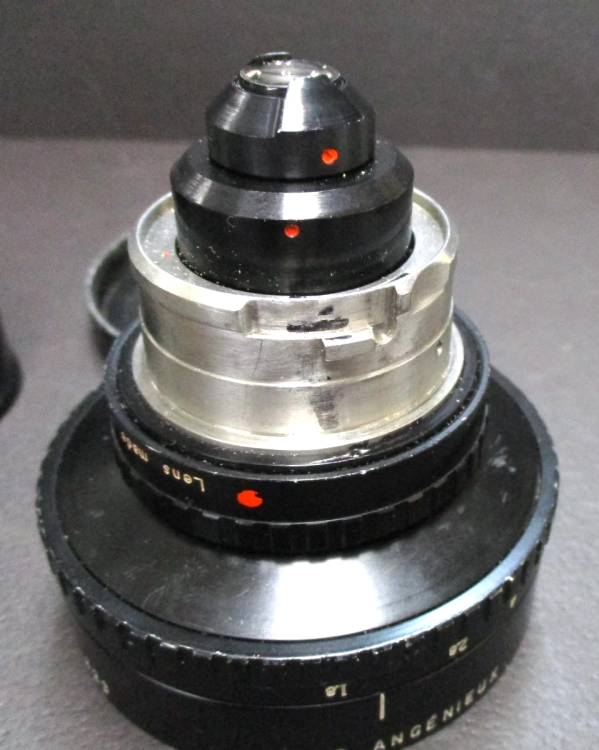
Duncan Brown
Premium Member-
Posts
557 -
Joined
-
Last visited
-
Arri Standard vs Bayonet mount for Wide Angle lenses
Duncan Brown replied to George Hill's topic in Lenses & Lens Accessories
Haha yeah good point, the ultrawides don't play well with others on a turret. Hope you have two port caps for the other holes 🙂 Duncan -
eBay and lots of patience are your friend. I MAY have a cord that would fit that - I bought it as a 16S cord and it turns out the IIA pins are much bigger. I'll try to look this weekend. Duncan
-
There's your power connector. If it's like the 16S, the pins are different sizes. That other connector just looks like a run of the mill BNC connector, usually for carrying signals of some sort, not power. Duncan
-
Arri Standard vs Bayonet mount for Wide Angle lenses
Duncan Brown replied to George Hill's topic in Lenses & Lens Accessories
And now an Arri-B Angie 5.9 shows up on ebay too - they're everywhere all of a sudden! https://www.ebay.com/itm/236198604963 Duncan -
Where to find a machinist for a custom lens clamp?
Duncan Brown replied to Jared Hall's topic in Lenses & Lens Accessories
We'll expect pictures here of the finished product! Duncan -
I always make my packs up out of D-sized cells. The couple of battery belts I've rebuilt (taking out the old dead NiCd batteries and replacing them with NiMh) have also used D-sized cells. Especially for running both the camera motor and the magazine motor at the same time, I think AAs just aren't enough. Duncan
-
OK, crow-eating time. On my latest camera, which I haven't actually shot any film in yet, it will run just fine with no film in it but if you tap the buckle switch, like I guess the end of a roll of film would, it does indeed shut it off, unlike my previous cameras. Resets by opening the sprockets (like you naturally do when loading a new roll of film) Learn something new every day... Duncan
-
Wow, I've had 4 16ST bodies (long story) and that is not what happened on any of them. They'd merrily run forever, film or no film. I guess that must be a feature that is not-working a lot! Interesting. Duncan
-
As far as I know, the buckle switch is only there to kill the camera if there's a jam (film gets too tight, loses loop, etc) There's not supposed to be anything that automatically kills the camera when the film runs out. You just have to keep an eye on that via the film footage/frame counters and the sound and the turning, or stopping of turning, of the feed spool knob. Duncan
-
Arri Standard vs Bayonet mount for Wide Angle lenses
Duncan Brown replied to George Hill's topic in Lenses & Lens Accessories
There's an Arri-B mount 5.7 Kinoptik on ebay right now, so there's proof that those exist too. Duncan -
(Zombie thread, but I just noticed it) The variable resistor built into the rotating cap of that motor can get very flaky after all these years. If you take it apart, clean up the windings and the contact point, ever so slightly shift the contact so it's running on a slightly different path, and manage to get it all back together again without breaking anything, it will probably work a lot better. I'd smear a thin film of contact grease on there too. Duncan
-
Arri Standard vs Bayonet mount for Wide Angle lenses
Duncan Brown replied to George Hill's topic in Lenses & Lens Accessories
Hey, lookie there, they do have one in Arri-B So now I have seen one that way! The Zeiss 8mm is a very very sharp lens, no problems there at all, but as you note, it's only "wide" not "crazy wide" (and I do love me some crazy-wide lenses, as you might have figured out.) Duncan -
Where to find a machinist for a custom lens clamp?
Duncan Brown replied to Jared Hall's topic in Lenses & Lens Accessories
I only have experience with these folks for fitting still-camera large format lenses to large format shutters, but they would appear to be up for just about any lens-related machining you could throw at them. Of course, you pay dearly for their experience and attention to detail. https://skgrimes.com/ Duncan


.thumb.jpg.32a8ef180f0966e046cc1cf4d178ccdf.jpg)

